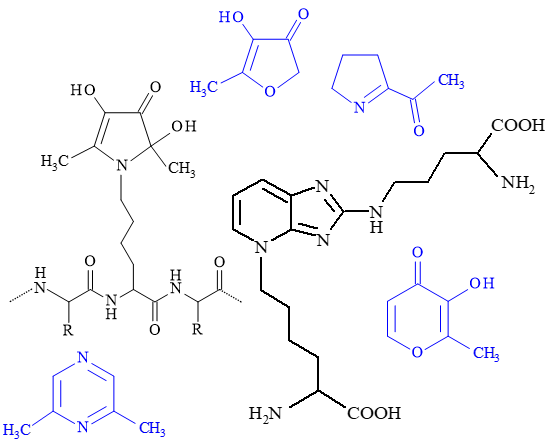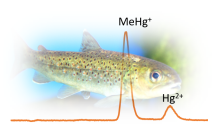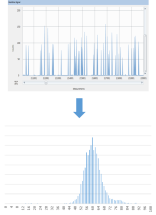Food Chemistry and Elemental Analysis
The Maillard reaction and other non-enzymatic browning reactions in foods

We address many aspects of non-enzymatic browning reactions - monitoring the formation of aromatic, coloured, biologically and redox-active products, the reactivity of sugars, or the glycation of proteins. We mainly focus on the most important intermediates of these reactions, such as reductones and reactive carbonyl compounds. We are also interested in reducing carbonyl stressors in reactions with phenolic substances and other food components.
Publications
- Cejpek K.: Vonné a chuťové složky sladů. Chemické Listy 108, 426–435, 2014.
- Čechovská L., Konečný M., Velíšek J., Cejpek K.: Effect of the Maillard reaction on reducing power of malts and beers. Czech Journal of Food Sciences, 30, 548–556, 2012.
Minerals and trace elements in food
We deal with the methodology of elemental analysis of biological materials (using AAS and ICP-MS) and monitor the content of essential and toxic elements in different foods. Besides the total content, we are also interested in the chemical forms of the elements and the changes in the content of elements during food processing. We cooperate with the atomic spectrometry group of the Institute of Analytical Chemistry of the Technical University of Applied Sciences.
Publications
- Fersahl M., Yankovych H., Studenyak Y., Bazel Y., Koplik R., Revenco D.: Combination of sequential injection analysis with an integrated [BF4]-potentiometric sensor for the kinetic determination of boron. Sensors and Actuators B - Chemical (2019) 297: UNSP 126778. (doi: 10.1016/j.snb.2019.126778)
- Koplík R., Mestek O., Komínková J., Borková M., Suchánek M. : Effect of cooking on phosphorus and trace elements species in peas. Food Chemistry 85, 31–39, 2004.
- Koplík R., Mestek O., Fingerová H., Suchánek M.: Validation protocol for the determination of copper in plant samples by isotope dilution inductively coupled plasma mass spectrometry. Journal of Analytical Atomic Spectrometry 14, 241–245, 1999.
Elemental speciation analysis
 Speciation analysis is a differentiated determination of individual forms (species, compounds) of a chemical element or fractions of these forms in a sample. Methodically, we combine different variants of liquid chromatography with ICP-MS. Among other things, we are interested in the fractions of iron, copper, zinc and other elements in legumes, cereals and pseudocereals and their possible changes during the processing of the raw materials and the digestion of the food as the representation of these fractions influences the bioavailability of the elements. We also deal with speciation analysis of selenium and mercury.
Speciation analysis is a differentiated determination of individual forms (species, compounds) of a chemical element or fractions of these forms in a sample. Methodically, we combine different variants of liquid chromatography with ICP-MS. Among other things, we are interested in the fractions of iron, copper, zinc and other elements in legumes, cereals and pseudocereals and their possible changes during the processing of the raw materials and the digestion of the food as the representation of these fractions influences the bioavailability of the elements. We also deal with speciation analysis of selenium and mercury.
Publications
- Revenco D., Vomackova M., Jelinek L., Mestek O., Koplik R.: Selenium species in selenium-enriched malt. Kvasny prumysl (2019) 65 (4) 134-141. (doi: 10.18832/kp2019.65.134)
- Koplík R., Klimešová I., Mališová K., Mestek O.: Determination of mercury species in foodstuffs using LC-ICP-MS: the applicability and limitations of the method. Czech Journal of Food Sciences 32, 249–259, 2014.
Analysis of inorganic nanoparticles

In collaboration with the Atomic Spectrometry group of the Institute of Analytical Chemistry of the Technical University of Applied Sciences we develop methods for the determination of silver nanoparticles in samples of biological origin. We use the single particle ICP-MS technique. During the analysis, due to the very fast measurement, the signals of individual particles are recorded and sorted by size. Based on a calibration, a particle weight is assigned to them, which can be converted into a diameter in nanometres. The result is data on the number and size distribution of the particles in the sample. We are interested in the changes in the state of the nanoparticles that can occur during the processing and digestion of food.
Publications
- Revenco D., Loula M., Mestek O., Koplík R.: Stanovení anorganických nanočástic v biologických materiálech a potravinách analýzou jednotlivých částic hmotnostní spektrometrií s indukčně vázaným plazmatem. Chemické Listy 113, 478–484, 2019
- Loula M., Kaňa A., Koplík R., Hanuš J., Vosmanská M., Mestek O.: Analysis of Silver Nanoparticles Using Single-Particle Inductively Coupled Plasma – Mass Spectrometry (ICP-MS): Parameters Affecting the Quality of Results. Analytical Letters (2019), 52(2):288-307. (doi: 10.1080/00032719.2018.1459657)
Other areas of interest
- biologically active substances of garlic and cruciferous vegetables (S-alk(en)yl-cysteine sulfoxides and their reaction products glucosinolates)
- aromatic substances of mushrooms
